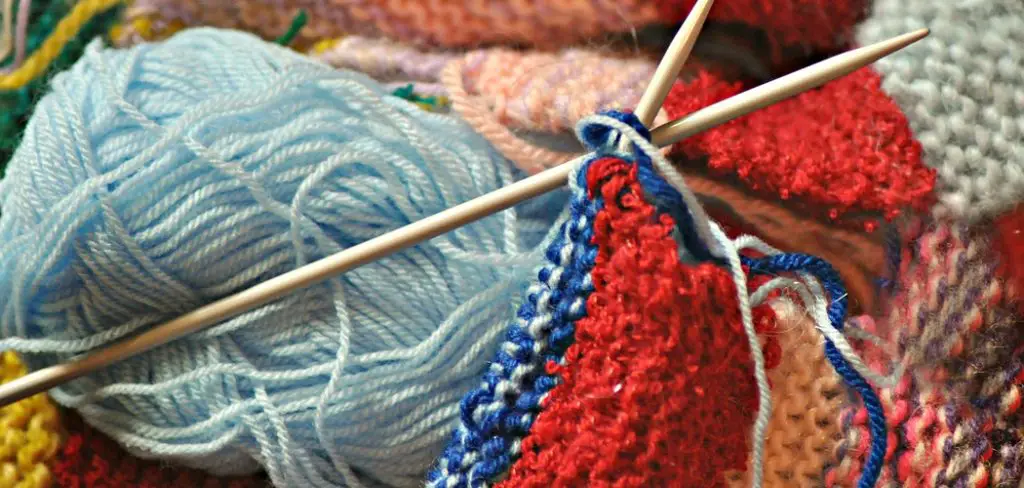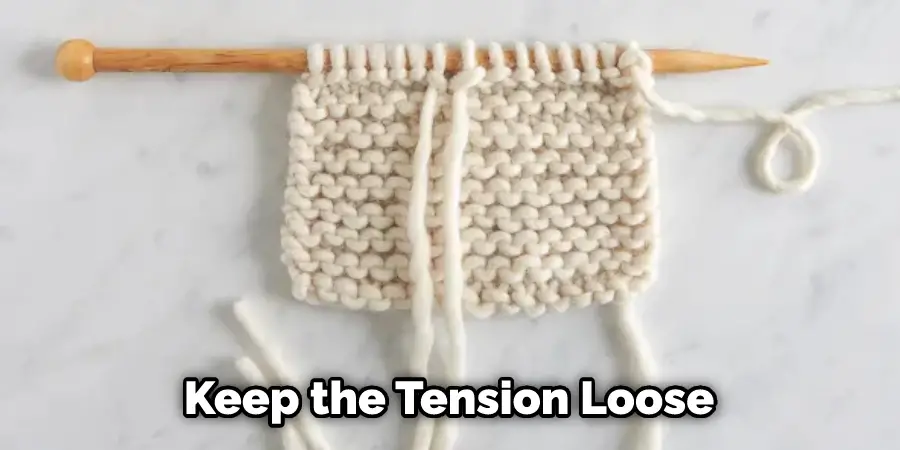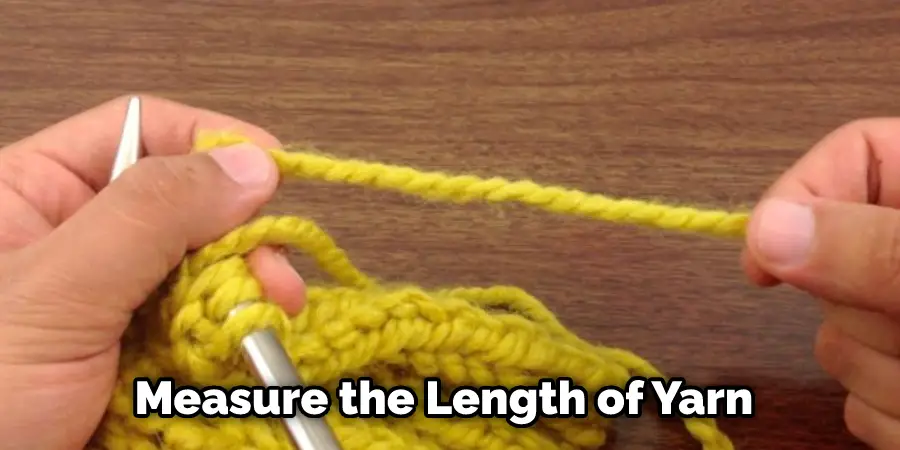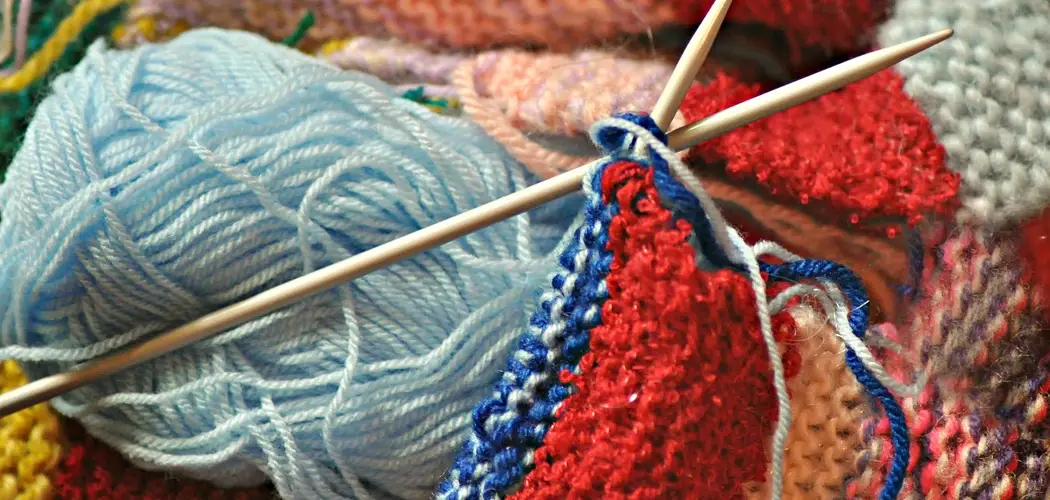Many knitting projects, such as sweaters and blankets, require large amounts of yarn to complete. To ensure that the color remains consistent throughout the project, adding a new skein when the old one runs out is necessary. When adding a new skein of yarn when knitting, start by making sure that you are using the same dye lot and color as the old skein; it is also important to ensure that the yarn you are adding has not been exposed to excessive sunlight or humidity, as this can cause discoloration.

Adding a new skein of yarn when knitting can be an excellent way to make your project look more aesthetically pleasing and intricate. Adding a new skein creates interesting color combinations that you wouldn’t be able to achieve if you used only one color throughout the entire project. You can find step-by-step instructions on how to add a new skein of yarn when knitting in this blog article.
Step-by-step Instructions for How to Add a New Skein of Yarn When Knitting
Step 1: Inspect Your Yarn
Before you start to add a new skein of yarn, it’s important to inspect the skein for any knots or tangles. If there are any knots or tangles, gently separate them before continuing.
Step 2: Gather Your Supplies
To add a new skein of yarn when knitting, you will need your old and new skeins of yarn, scissors, and a tapestry needle. Cut the old yarn at a length that is approximately twice as long as your knitting project. Make sure to leave enough of the old yarn to reattach it once you’ve finished adding in the new skein of yarn.
Step 3: Tie the Old and New Yarn Together
Tie the ends of your old and new skeins together in a loose knot or slipknot, leaving enough slack for you to pull both ends through when it comes time to weave them in. Using the tapestry needle, attach the new yarn to your knitting needles. Ensure that the knot you tied in Step 4 is at least 6 inches from where you are attaching the new yarn.
Step 4: Begin Knitting With The New Yarn
Begin knitting with the new skein of yarn, using the same pattern you followed with the old skein. Once you have knitted about three to four rows with the new yarn, it’s time to weave in your old yarn tail. Take the ends of both skeins of yarn and thread them through the tapestry needle.
Step 5: Weave in The Old Yarn Tail
Begin weaving the old yarn tail into the back of your knitting project, making sure to weave it in for about three to four inches. Be sure to keep the tension loose on your stitches so that you don’t pull them together too tightly. Once you have finished weaving in the old yarn tail, cut it off at a length that is approximately 6 inches away from where you just weaved it in.

Step 6: Weave in The New Yarn Tail
Finally, take the end of your new skein of yarn and thread it through the tapestry needle. Begin weaving in the new yarn tail like you did with the old yarn tail, making sure to weave it in for about three to four inches. Cut off any excess yarn at a length that is approximately 6 inches away from where you just weaved it in.
Safety Tips for How to Add a New Skein of Yarn When Knitting
- Make sure the yarn you are using is appropriate for your project and that it matches the gauge of your knitting needles.
- Take proper care when handling the new skein of yarn. Avoid stretching or tugging on the yarn, as this will cause it to become damaged and unusable.
- Before adding the yarn to your project, check for knots and tangles. If you find any, untangle them using a tapestry needle or crochet hook.
- Dissolve loose ends from the new skein before adding it to your knitting by cutting off a few inches of yarn and then tucking the end back into its own strand.
- To add the new skein of yarn, tie a knot at the end of the strand you are currently knitting with, and then take the tail of the new skein and make a slipknot around your knitting needle.
- While knitting, be mindful to alternate between each skein every few stitches. This will help ensure that the colors blend in a seamless manner.
- To avoid tangles or knots, make sure the skeins are loosely wound and placed far away from each other.
- When you have finished adding your new skein of yarn to your project, it is important to secure the tail properly, so it doesn’t unravel. You can do this by weaving in the tail with a tapestry needle or tying a few knots along its length. This will ensure your finished project looks neat and professional.
By following these safety tips, you can learn how to easily add a new skein of yarn when knitting and ensure that your finished garment looks great.
How Should You Store and Organize Multiple Colors of Yarn When Knitting?
- Sort your yarns by weight and type, such as worsted-weight wool or DK cotton. This will make it easier to find the right yarn for a project later on.
- Label each piece of yarn with its fiber content, color, and weight so you can quickly identify it when you’re ready to use it.
- Store your yarns in a cool, dry place away from direct sunlight and other sources of heat or humidity that can cause damage to the fibers.
- Put each skein of yarn into a separate bag or container to protect it from dirt, dust, and moths. If you want to store multiple skeins of the same color together, you can use a storage box or basket.
- Keep your yarn organized by dividing it into categories: project type (e.g., baby projects, garments, accessories) or fiber content (wool, cotton, silk).
Organizing and storing your yarns properly will help keep them in good condition and make it easier for you to find the right yarn when needed.

How Can You Avoid Tangles and Knots When Adding a New Skein of Yarn to My Project?
- Before you begin, ensure the tail of your old skein is securely woven into your knitting project, and there are no loose strands that can tangle up with the new skein.
- Once you have identified where to attach the new yarn, find a place in the new skein away from any knots or tangles.
- Take a few inches of the yarn from the skein and ensure it is not twisted before attaching it to your project.
- Tie a basic knot between the old and new yarns, ensuring that the tails are at least 3-4 inches long before you begin knitting with it. This will prevent the yarn from unraveling.
- Gently pull on both ends of the new skein while holding your project to ensure that it is securely attached and there are no tangles or knots in between.
- Finally, start knitting with the new yarn and ensure you keep the tension even so that all stitches are knitted similarly.
Following these steps, you can easily add a new skein of yarn when knitting without tangles or knots.
How Do You Calculate the Correct Amount of Yarn to Use for an Entire Project?
When you are adding a new skein of yarn to an existing project, it is important to calculate the correct amount of yarn needed for the entire project. This calculation will depend on several factors, such as the size and shape of the item being made and how many colors or textures of yarn are used.
To begin, measure the length of yarn needed for the entire project, considering any increases or decreases that may be needed. If a pattern is being followed, refer to the pattern instructions regarding how many skeins of yarn are recommended. Make sure to note whether a single strand or multiple strands of yarn will be used, as this will affect the total amount of yarn needed. Adding a new skein of yarn when knitting can be done easily if you take the time to calculate the correct amount of yarn needed for the entire project.

How Can You Prevent the New Skein From Unraveling as I Knit With It?
- Begin by cutting a few inches of the new skein to create a tail before joining it with your existing yarn.
- Pull apart each end of the cut to separate the plies, creating 2 loose ends.
- Find where you need to attach your new skein and insert one of the tails into the space between the two stitches of your project.
- Gently pull the tail through, allowing the yarn to overlap slightly with the existing strand.
- Holding both ends of the skein in one hand, pick up both strands with your other hand and tie them together using a secure knot such as a square knot or slip knot.
- If necessary, weave the ends in with a tapestry needle to hide them within your project.
- Before continuing to knit with the new yarn, give it a gentle tug to ensure that it’s securely attached and won’t unravel while you work.
Following these steps will help prevent the new skein from unraveling as you knit with it. With a little bit of care and attention, your project will look neat and professional.

Conclusion
In conclusion, adding a new skein of yarn when knitting is a relatively easy process if done correctly. Working with multiple strands of yarn can produce interesting and complex results, but it does come with some challenges. To ensure that the knitted project looks its best, take the time to add a new skein of yarn when needed properly.
Doing so will reduce the possibility of knots and tangles and create a seamless transition between the two colors. And remember to keep your yarn smoothly untwisted throughout the entire process. I hope reading this post has helped you learn how to add a new skein of yarn when knitting. Make sure the safety precautions are carried out in the order listed.
You Can Check It Out to Make a Flower Crown With Paper

